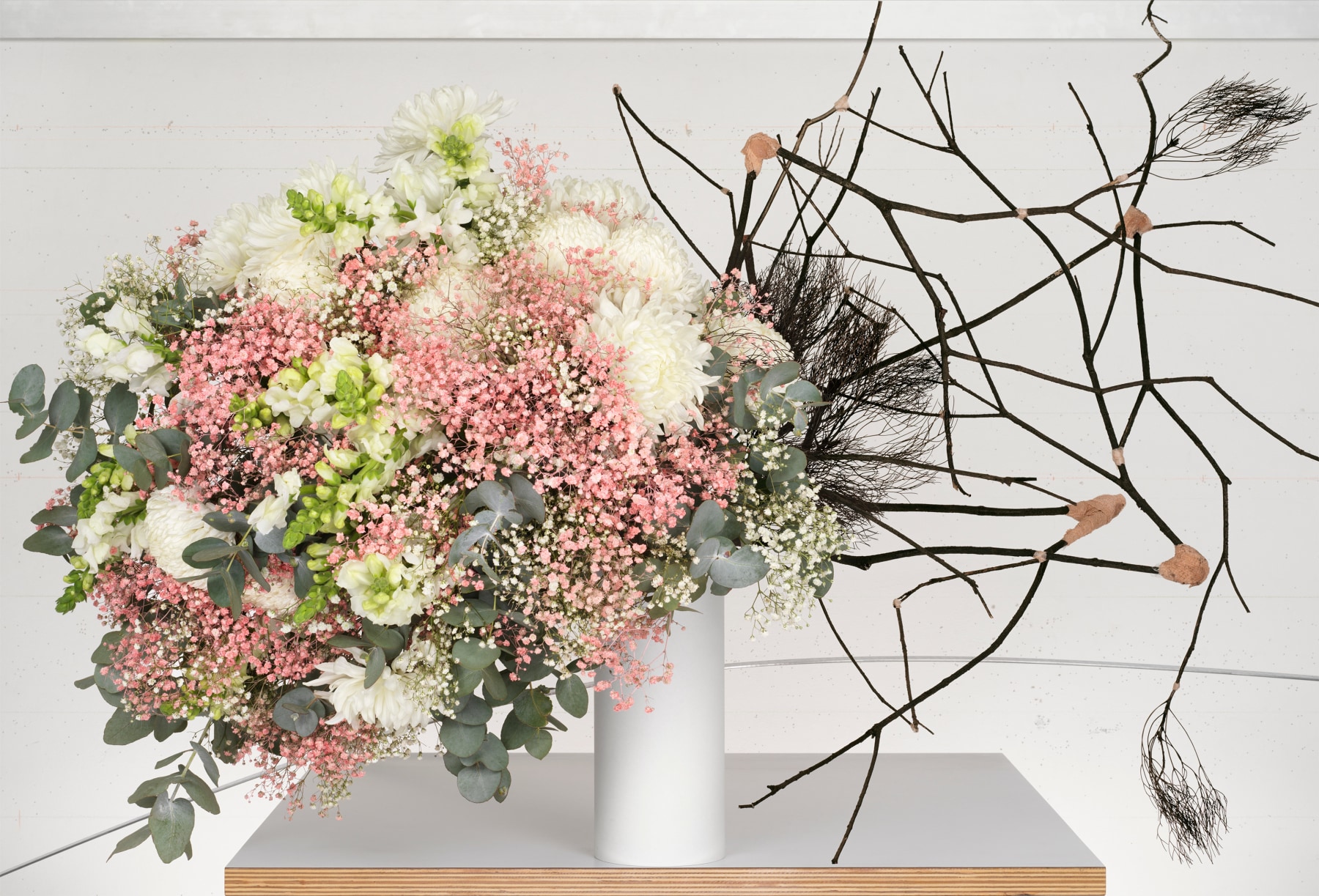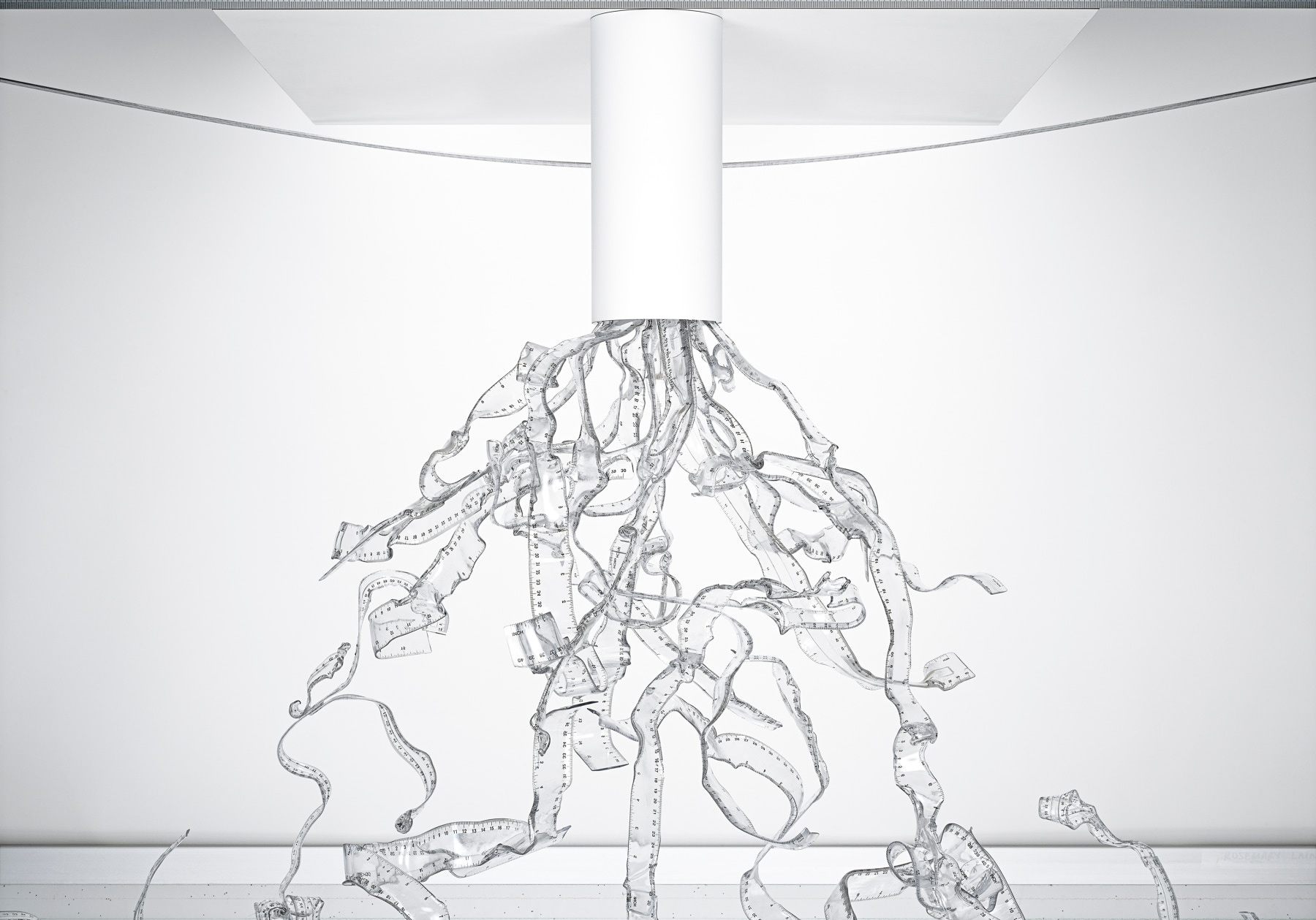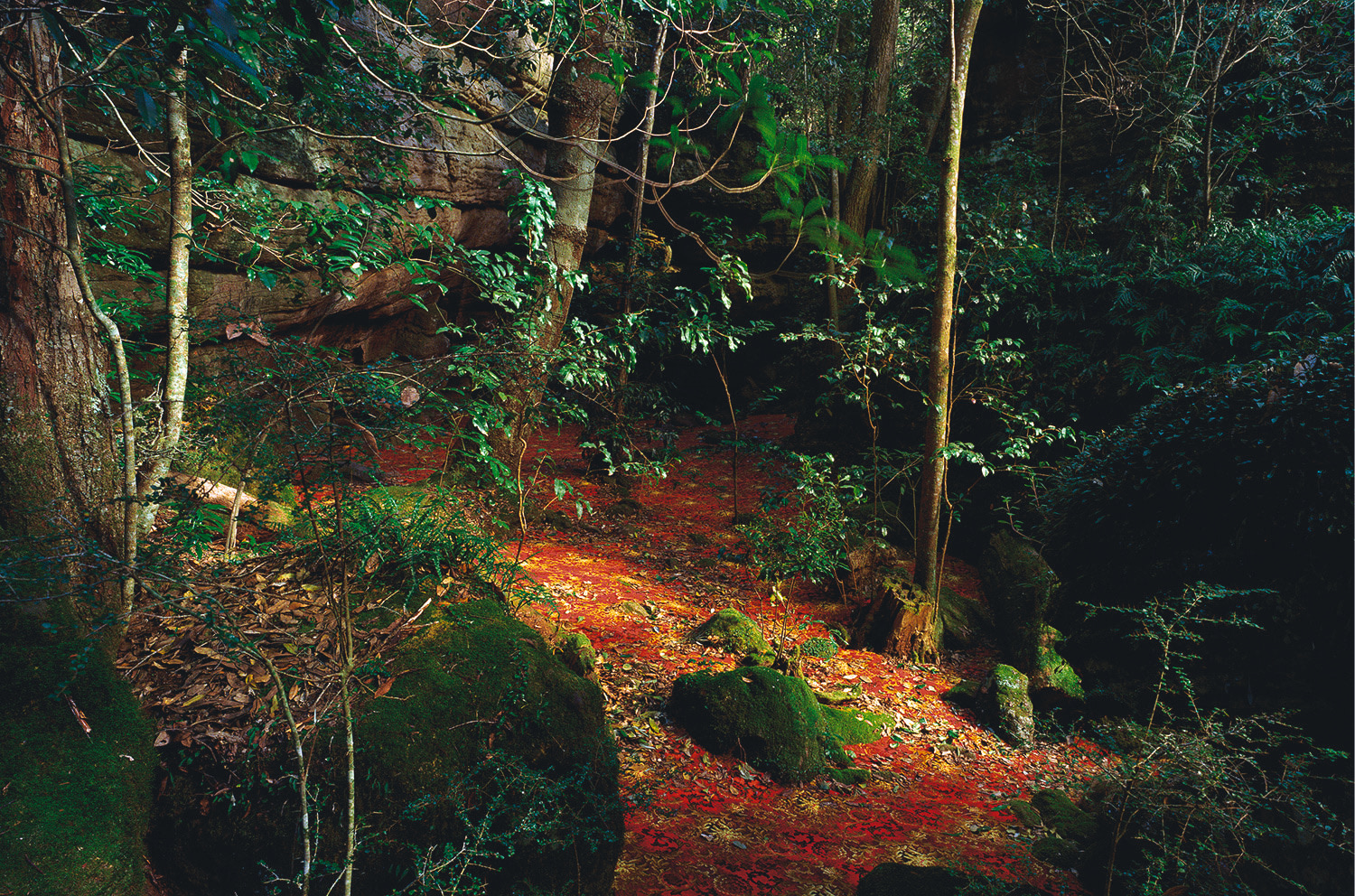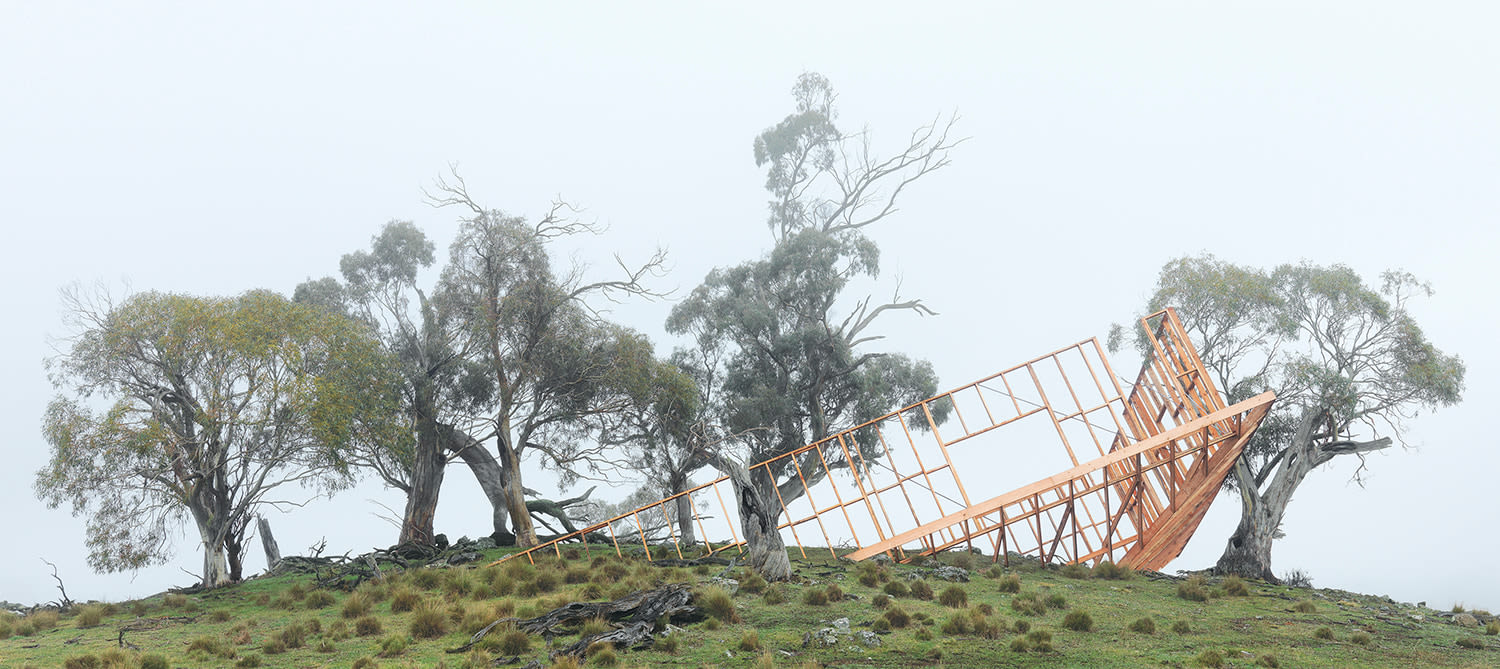what happens when the still-life painting I am looking at becomes untrue?
what happens when the idea-promise of a domesticated continuum is broken?
what happens when domesticated interior views become a veneer, another way to block, as opposed to see?
what happens when the events that define us are so over-imaged that to repeat their language has the potential to become perhaps another kind of compliance?
what happens when directives, words and images - muffle the sound of what happened?
– Rosemary Laing, studio notes, 2021
Galerie Lelong & Co. is pleased to present Rosemary Laing: poems for recent times, new works from the artist's latest series of the same title. Born in 1959 in Brisbane, Australia, Rosemary Laing originally trained as a painter before moving to the medium of photography in the late 1980s. Known for her photo-based work that is cinematic in vision and created with real-time performance and physical installation as opposed to digital manipulation, Laing meticulously stages interventions in culturally and historically resonant locations across Australia.
Her work is informed by post-colonial perspectives on the occupation and ownership of land and speculates upon how the past intersects with the present situation. Laing frequently works in series, creating thematic bodies of work that are large in scale and scope and accumulatively form an ongoing narrative of events that have impacted cultural consciousness.
For any sales enquiries, email us at art@galerielelong.com.

Rosemary Laing, still life with burnt twigs and bandages, 2021. Archival pigment print, Image size: 32 5/8 x 44 1/2 in (82.9 x 113 cm), Paper size: 35 7/16 x 47 1/2 in (90 x 120.7 cm), Edition of 8 plus 2 artist's proofs (GP2745).ENQUIRE

Rosemary Laing, still life with rulers, 2021. Archival pigment print, Image size: 32 5/8 x 44 1/2 in (82.9 x 113 cm), Paper size: 35 7/16 x 47 1/2 in (90 x 120.7 cm), Edition of 8 plus 2 artist's proofs (GP2746). ENQUIRE

Visualization of framed works
(L) still life with burnt twigs and bandages with the inner-frame painted floral pale pink and eucalyptus grey-green with an overall creamy white coloured frame.
(R) still life with rulers with a pale grey inner frame at the top and an overall creamy white coloured frame.
The frames have been designed by Rosemary Laing and reference works by Australian women painters such as Dora Chapman of the late 1940s, post-World War II period. At that time, small paintings by women artists featured frames where the inner-frame was highlighted with key colours from the painted image itself.
Laing notes that coloring the inner-side sections of her frames here creates an interior colour glow, subtly empathetic to the photograph as well as providing a gentle emphasis to the sense of structural container that is the frame.
Balancing Acts
by Tanya Peterson
What happens before recovery, in the too soon forgotten moments of loss and the impacts that endure beyond them? How does one move on when grief and disaster are still constant companions, underscoring collective narratives of adversity and survival, which continue to unfold locally and globally? Rosemary Laing’s new series, poems for recent times (2021), seeks out these often irreconcilable spaces of disquiet and reflects on how they shape our lived experiences of place.
Most recently in Australia, the complex dynamics of place were irrecoverably changed in 2019-20, during what became known as Black Summer, the worst fire season on record. Between July 2019 and February 2020 there were 11,141 bush & grass fires in NSW, which burnt through 5.4 million hectares of land and native habitat, killing an estimated 800 million animals, causing 25 deaths, and destroying 2,439 homes.[i] The severity and extent of the fires were so explosive, at times, they created their own weather. Multiple fire thunderstorms intensified the already extreme local conditions, pushing toxic smoke high up into the atmosphere, where
it travelled across the South Pacific over the course of a year before cycling back to Australia. Everything’s connected and entangled and looping and spiralling.[ii]
A year on and still affected by the events of Black Summer, while also grieving the recent death of her father (a loss made harder due to COVID-19 travel restrictions), Laing travelled to her south coast home and the Shoalhaven fire grounds surrounding it. The Shoalhaven is Yuin country. It stretches along the southern coast of New South Wales and is of significance to Laing, not only as someone who is part of the community, but as the place she’s spent over the last 20 years making site-specific works for the series groundspeed (2001), swanfires (2002-04 and 2013-15), The Paper (2013), and Buddens (2017). When walking through the now scarred grounds, Laing began gathering scorched tree fragments from the still blackened forest. Once home, she set about bandaging their delicate limbs at multiple tension points, as one might dress and mend a fresh wound. These bereaved actions would later signal the start of her new work.

Rosemary Laing, groundspeed (Red Piazza) #3 2001, C Type photograph, 108 x 151 x 6.5 cm (framed size), edition of 15 + 2AP. From the series groundspeed 2001
Upon returning to her Sydney studio, Laing composed still life with burnt twigs and bandages 2021. She placed the mended sticks and sprigs in a modest vase, alongside a large bunch of fresh flowers, which she’d rearranged from a floral bouquet. The use of flowers in this setting operates as a somewhat ambiguous signifier of mortality. While reminiscent of still life traditions, such as vanitas painting and its signs of life and death that hang in the balance, the abundant flowers can also be understood as a commemorative sign of loss, particularly when read in contrast to the fragile remains of the charred twigs and branches. Coupling emblems of solace with distress, the image’s allusions to communal rituals and remedies are suggestive of shared sorrows and unresolved pain. Trauma resides at the heart of these flowers and offshoots, redolent of the lands from which they spring.
After Black Summer, the word 'resilience' became a recurrent trope in the national framing of the fires.[iii] The ruling Liberal/National (Coalition) party’s position on climate has long been one of disconnect. And, at the time, their propagation of the term did little to ameliorate the current mood of sorrow and anger.[iv] There was no mention of accountability or a call to action in relation to the ongoing climate emergency.
Instead, the federal government’s spin felt more like an attempt to screen and overwrite the trauma of the fires with narratives of heroism and survival, leaving the collective experience of grief too quickly replaced with a rhetoric of optimism, after the warnings of disaster heeded too late.[v]
In still life with rulers 2021, the second work from Laing’s new series, the root of this predicament appears seeded in a tangled logic of forms. Buckling rulers take the place of table-top flowers, their curling forms caught in a strange glow of soft light, where the spectre of hope blooms from an entropic system. Offset against this underlying disorder are a number of standard measures conjuring the set's architectural framework. Notably, a pair of long rulers and a metal straight (which Laing uses for trimming large prints and fieldwork, respectively) delineate the edge of the photograph's pictorial space and its material ground. These studio and location tools denote the photograph itself as a fixed horizon or imagined frontier. They initially seem to map and scaffold the scene, restoring order to the unfolding chaos. Upon closer inspection, however, they function more as floating indexes linked to a larger, unseen reality — abstractions of a situation which can’t be grasped in its entirety, like front-page statistics circulating in the wake of a crisis. The image’s conceit is that it offers these metric constraints as another set of failed measures, where the balance of things comes undone.

Rosemary Laing, Prowse 2010, C Type photograph, framed size: 127 x 264 x 7.5 cm, edition of 8 + 2AP. From the series leak 2010.
The unsettling and repeated acts of repairing and arranging in both these new works present scenes of home life and homeland gone awry. These actions and themes evoke Laing’s previous series, such as the seemingly misdirected labour in leak (2010), where the framework of a house is built upside down into the terrain, as if born from a troubled land or the by-product of a fraught relationship to home. They also recall a dozen useless acts for grieving blondes (2009), and the performative grammar of grief that plays out in the aftermath of an unseen, and yet pervasive, trauma.
In her new imagery, however, the persistent and disarming way in which empathetic gestures are enacted indicates a deliberate intent. There’s something purposeful in the way these efforts are repeatedly geared towards the appearance of domestic and empirical order. Their displaced pragmatism conveys what could also be considered a sign of hope, a desire to continue to make sense of, and bear witness to, the discord inherent in what is lost and what remains.
Writing on recent disasters and the continuing impacts of the pandemic, Rebecca Solnit makes the point that “hope is not optimism that everything will be fine regardless...[or that] everything was fine before disaster struck”.[vi] This type of optimism would be the stuff of resilience in its current political guise. Instead, she argues hope is a form of “clarity”, a way to focus our grief on what we feel is worth fighting for, and also what’s worth fighting against. For Laing, events such as these are not something to simply get over, but something to recognize and grapple with in the face of wilful denial. In other words, her hope could be seen as a form of activism — a call to keep acknowledging and shifting the balance of silence and inaction towards change.
- Tanya Peterson, September 2021

Notes
[i] Lesley Hughes, Will Steffen, Greg Mullins, Annika Dean, Ella Weisbrot and Martin Rice, Summer of Crisis, Climate Council of Australia Ltd, 2020. Their report looks specifically at the effects of the fires in New South Wales and the ACT. While the discussion of Laing’s work relates specifically to her connection with the Shoalhaven region of New South Wales, it is important to note that Western Australia, Queensland, South Australia, ACT, Victoria, and Tasmania were heavily impacted by fires too.
[ii] Research into the “super outbreak” of fire thunderstorms suggest these “feedback” effects are indicative of climate change impacts which, in turn, function as climate change drivers. See for example: D.A. Peterson, M.D. Fromm, R.H.D. McRae (et al), “Australia’s Black Summer Pyrocumulonimbus Super Outbreak Reveals Potential for Increasingly Extreme Stratospheric Smoke Events”. Nature: npj Climate and Atmospheric Science, no. 4, vol. 38, 2021. https://doi.org/10.1038/s41612-021-00192-9
[iii] More recently, the notion of ‘resilience’ was formally enshrined in the federal government's economic policy. During the May 2021 budget announcements, and in response to the Royal Commission findings into the Black Summer fires, the Morrison government launched a National Recovery and Resilience Agency. See: https://recovery.gov.au/ [accessed 10 August, 2021].
[iv] In mid-December 2019, a photograph was shared on social media and news channels of the Australian Prime Minister, Scott Morrison, holidaying in Hawaii, while at home the country was experiencing an unrelenting and unparalleled fire season. The comparative optics of these two situations generated significant public outcry and criticism of Morrison and the federal government. See, for example, Stephanie Dalzell, “Scott Morrison says he accepts criticism for Hawaii holiday during bushfires, apologises for any upset caused”, ABC News, online, https://www.abc.net.au/news/2019-12-22/prime-minister-scott-morrison-hawaii-holiday-bushfires/11821682 [accessed 22 December, 2020].
[v] In relation to the Black Summer bushfires, 'Emergency Leaders for Climate Action' (ELCA) (comprised of former senior fire and emergency experts from the field) issued a collective warning to the government on 10 May, 2019 about the imminent threat of “increasingly catastrophic extreme weather events” and “the need for ‘national firefighting assets’, including large aircraft, to deal with the scale of the threat”. They were not given a meeting with government ministers until 3 December, 2019, well after the bushfires had taken hold. See: https://emergencyleadersforclimateaction.org.au/our-story/ [accessed 28 June, 2021].
[vi] Rebecca Solnit, “The Long Read: ‘The impossible has already happened’: what coronavirus can teach us about hope”, The Guardian, online, 7 April, 2020, https://www.theguardian.com/world/2020/apr/07/what-coronavirus-can-teach-us-about-hope-rebecca-solnit [accessed 9 April, 2020].